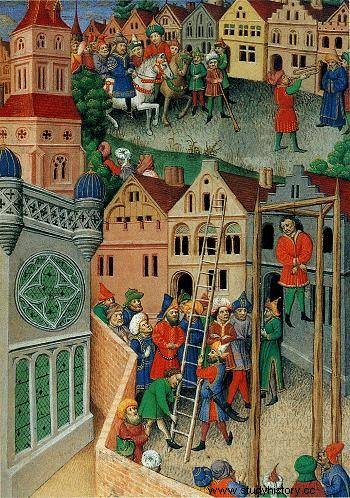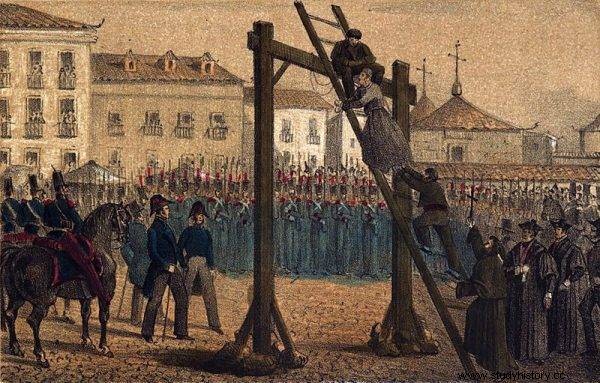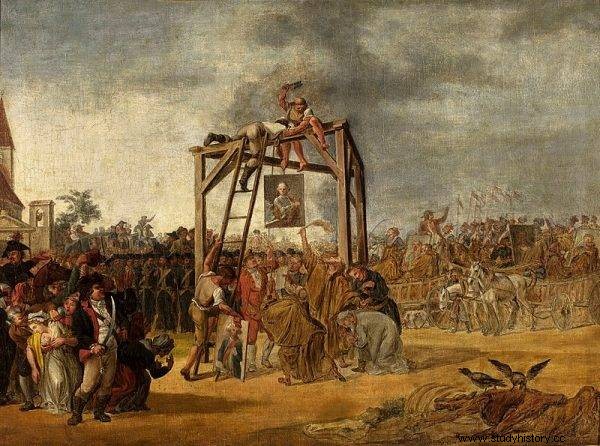The gallows was considered an unclean place. Honest people avoided her from a distance. However, it did need repair from time to time. And here the trouble started ...
The genesis of the notoriety of the gallows goes deep into the past. Already in the Middle Ages, accidental contact with the place of execution, and especially with the gallows, could permanently stigmatize a person and throw him out of society. Only the executioner and his assistants had intercourse with her with impunity for which it was sometimes even an everyday workplace. Even the brick gallows, however, were subject to the tooth of time, and consequently demanded at least a superficial maintenance. However, specialized craftsmen were required to carry it out. Primarily carpenters, bricklayers and blacksmiths.
From renovation to degradation
The city craftsmen, concentrated in guilds, never rushed to renovate or build a new gallows. Despite assurances from the city authorities, they believed that they had too much to lose. Especially that working on such a commission posed a risk of permanent stigma . Its consequence could be not only pointing fingers in the street, but also removal from the guild and expulsion from the city.

The gallows needed renovation from time to time
These fears were not alleviated even by the famous "Carolina" from 1532 ( Constitutio Criminalis Carolina ), guaranteeing people participating in the renovation of the gallows that their good opinion will remain intact.
A recipe for fear
The way out of this stalemate was a specific ritual. It may have been built in the Middle Ages, but it is best known for its accounts from the 17th and 18th centuries. It was used all over Central Europe, also in Polish cities.
It required participation in the renovation or construction of the gallows, both representatives of the highest municipal authorities and all members of building guilds , from the masters to the students. This guaranteed that the odium (stigma) threatening the participants in the project would be evenly distributed among all. Consequently, no one will be stigmatized in any particular way. In other words, all participants will keep their good opinion intact. If someone was unable to come to work, he was required to send a replacement. City officials watched over the attendance list, keeping special registers for this event.
Christmas pageant
The local executioner usually reported the necessity to repair the old gallows or build a new one. After the necessary building materials had been collected, the city authorities announced the date of the project to all building guilds. On the designated day a solemn march of those interested to the city gallows was organized, giving the event the character of a public holiday , also available to potential onlookers. The latter also acted as involuntary witnesses. They could, if necessary, confirm that the ritual was fully and smoothly performed. For the participants of the work, this opinion was simply crucial.

The renovation of the gallows was becoming a city celebration
When starting the task, the participants of the expedition gathered in the morning in front of the house of the clerk who chaired the project. Then, after forming a column and listening to an appropriate speech, people walked past the heart of each city - the town hall. Sometimes the marchers were served drinks from the town hall's basement to raise their morale. The column then went to the city gallows. Most often the same route as the convicts normally led there.
The procession was traditionally very solemn. It was opened by city officials dressed in festive clothes and armed with parade weapons, sometimes on horseback or in a carriage. They moved to the sound of drums and trumpets played by guild musicians or the city garrison orchestra. The craftsmen moved in a strictly defined order. The basic tools of work were in their hands. For example, carpenters marched with axes and axes, and masons with trowels. Colorful guild banners fluttered over their heads. City soldiers escorted the participants of the expedition to the gallows in wealthier centers. The column was also accompanied by the transport of necessary building materials.
Glove ritual
After reaching the gallows, renovation or construction works were initiated by the official chairing the project. Previously, he wore leather, usually white gloves. He hit one of the beams delivered to the work site three times with the given ax or hatchet. Then he handed over the tool with gloves to the hands of the oldest member of the carpentry guild. This one repeated the ritual. The ax or the hatchet with the gloves circulated from hand to hand between the successive members of the guild including apprentices and apprentices.

The formal completion of the construction or renovation of the gallows was often its "technical acceptance"
The ritual was also repeated in the case of subsequent guilds, but only the tools and gloves were changed. Great care was taken to ensure that no one was left behind. Departure from this rule could have dire consequences for everyone. At the end, the youngest of the students gathered under the gallows collected the tools used during the work and symbolically tossed them over his head, announcing that they would never be used again. In practice, they were often later - together with unused wood - in the hands of the executioner's helpers. The gloves used during the works were left, in a symbolic gesture of cleansing, under the gallows.
Worry good drink
At the end of the project, the column was re-formed and the city was officially returned to the city. There the artisans went to their guild inns to sit down with a beer or wine. It also happened that a meal was organized in a wider group, taking advantage of the generosity of the city authorities. This feast was not a coincidence. It also had a ritual dimension and allowed to consolidate the community, impaired by the awareness of the nature of the work just done.
The formal completion of the construction or renovation of the gallows was often its "technical acceptance" by the local executioner. Some "masters of justice", feeling excluded from the described "ceremony", demanded various gifts from the city authorities, most often new clothes. They must have quietly counted on the good humor of the city council, glad that one of the main symbols of the judiciary had regained its splendor.
Bibliography:
- Otto Beneke, Von unehrlichen Leuten. Cultur-historische Studien und Geschichten aus vergangenen Tagen deutscher Gewerbe und Dienste, mit besonderer Rücksicht auf Hamburg , Hamburg 1863.
- Paweł A. Jeziorski, Social margin in large cities of Prussia and Livonia in the late Middle Ages and early modern times , Toruń 2009.
- Edmund Kizik, Ceremonies during the renovation of the gallows and pillars in Gdańsk from the second half of the 16th to the beginning of the 19th century. Contribution to the history of public ceremonies in the modern period , Modern Times, vol. 24:2011, pp. 77-89.
- Karolina Pogorzelska, Executioner's craft in Jelenia Góra based on early modern city bills , Yearbook of Jeleniogórski, vol. 47:2015, pp. 61-70.
- Johannes Warncke, Handwerk und Zünfte in Lübeck , Lübeck 1912.
- Daniel Wojtucki, Public execution sites in Lower Silesia from the 15th to the mid-19th century , Katowice 2009.
